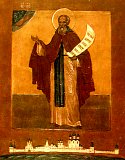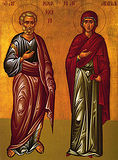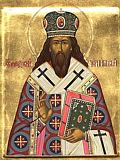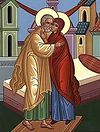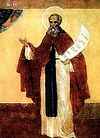

| Previous day | Next day |
| Old Style
September 9
|
Thursday |
New Style
September 22
|
| 15th Week after Pentecost. Tone 5. | No fast.
|
![]() Afterfeast of the Nativity of the Theotokos.
Afterfeast of the Nativity of the Theotokos. ![]() Holy and Righteous Ancestors of God Joachim and Anna.
Holy and Righteous Ancestors of God Joachim and Anna. ![]() Martyr Severian of Sebaste (320).
Martyr Severian of Sebaste (320). ![]() St. Joseph, founder of Volokolamsk (Volotsk) Monastery (1515).
St. Joseph, founder of Volokolamsk (Volotsk) Monastery (1515). ![]() Uncovering and translation of the relics of St. Theodosius, archbishop of Chernigov (1896).
Uncovering and translation of the relics of St. Theodosius, archbishop of Chernigov (1896).
St. Theophanes, confessor and faster, of Mt. Diabenos (299). Commemoration of the Third Ecumenical Council (431). Blessed Nicetas the Hidden, of Constantinople (12th c.). St. Onuphrius of Vorona, Moldavia (1789).
New Hieromartyr Zachariah (Lobov), archbishop of Voronezh (1937). New Hieromartyr Andronicus (Surikov), hieromonk, of Moscow (1938)
St. Kieran (Ciaran) of Clonmacnois (Ireland) (ca. 545). St. Omer, bishop of Therouanne (670). St. Joachim, founder of Opochka Monastery (Pskov) (ca. 1550). St. Joachim, monk of the St. Nicholas- Shartomsk Monastery in Suzdal (1625). St. Cyriacus of Tazlau Monastery, Moldavia (1660).
Repose of Elder Joachim of St. Anne’s Skete, Mt. Athos (1950).
Thoughts for Each Day of the Year
According to the Daily Church Readings from the Word of God
By St. Theophan the Recluse

Thursday. [Gal. 3:23-4:5; Mark 6:30-45]
And people ran afoot thither out of all cities…and came together unto Him. This is to the Bethsaida desert, where the marvellous filling of five thousand with five loaves of bread and two fishes was performed. What drew the people to the Lord? Sympathy towards the Divine. The Divinity of the Lord, hidden under the cover of human nature, revealed itself in word, deed, gaze, and in all that was visible in the Lord. The manifestations of the Godhead awakened a feeling of the Godhead hidden in the heart, and through it drew people to the Lord. Nobody has power to hold back such a movement toward the Lord, not even the one who feels it, because it is deeper and stronger than all other movements. The same Divinity, manifested later by the Saviour, drew people of every tongue under the heavens to Him. It has been the same throughout the entire history of the Church, even to this day. A small trace of the Divine draws people to itself. What follows from this experience everywhere and at all times of our spirit’s aspiration for the Divine? What follows is that what is Divine, what is supernatural—is the Godhead, its source. This aspiration lies in the foundation of our spirit and constitutes its nature, as anyone can see from our intellectual, aesthetic and practical concerns. But in nature there cannot be lies and deception; consequently they do not exist in this aspiration for the Godhead. From this it follows that God and the Divine exist, and that the naturalists, in rejecting what is supernatural, are going against the nature of the human spirit.
Articles
 Holy, Righteous Ancestor of God, AnnaSaint Anna was the daughter of Matthan the priest, who was of the tribe of Levi. St Anna’s family came from Bethlehem. |
 Martyr Severian of SebasteThe Holy Martyr Severian suffered for Christ in Armenian Sebaste during the governorship of Licius, when Christians were persecuted under the emperor Licinius. |
 St. Theodosius Of ChernigovSt Theodosius’ ascetic way of life and the secret help which he extends to all who raise up prayers to him bear witness to the grace-filled gifts he acquired. |
 Blessed Nicetas the Hidden of ConstantinopleSaint Nicetas the Hidden lived at Constantinople and occupied the position of “chartolarium” (“letter-writer”). |
